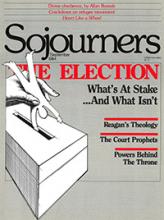The underground railroad led north during the slavery era. Those who were led out of bondage traveled at night, mostly by foot or by wagon, and always in danger. Passengers, conductors, and stationmasters formed a vast network of ordinary people engaged in extraordinary endeavors and united in their moral revulsion at the "peculiar institution."
Many were caught and punished. Yet thousands were delivered from captivity because many people were willing to risk whatever was necessary to provide sanctuary.
Today, the church is showing the same moral courage in the sanctuary movement for Central American refugees. Thousands are again finding a haven—this time from the spiraling cycle of violence in their homelands. The new "railroad" leads to almost 150 churches that have declared themselves sanctuaries, and even to Keene, New Hampshire, the first town in the country to designate itself a public sanctuary.
For the first time, workers on today's railroad are facing legal sanctions for their activity. While deportations continue for Salvadorans, Guatemalans, and others, recent indictments and trials in the Southwest have targeted the sanctuary railroad.
The point of embarkation on today's railroad lies in the war zones of Central America. As the toll from death squads and counterinsurgency mounts, refugee movement within Central America increases. Salvadorans in Honduran camps are subject to sporadic attacks both from Honduran troops and Salvadoran soldiers training at U.S. bases within Honduras. Current U.S. policy is pressuring Honduras to relocate refugee camps away from the El Salvador-Honduras border, in order to create a militarized "free-fire" zone.
Read the Full Article

